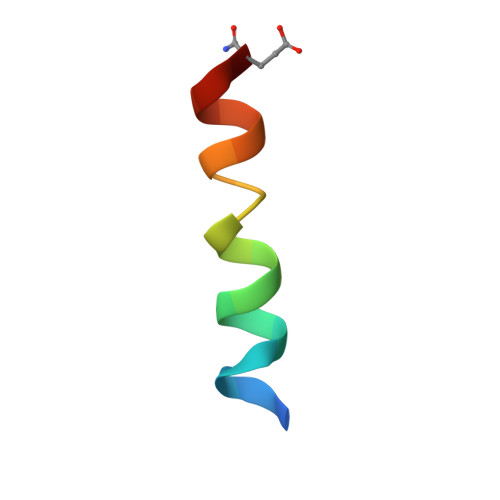Structural modifications to a high-activity binding peptide located within the PfEMP1 NTS domain induce protection against P. falciparum malaria in Aotus monkeys.
Curtidor, H., Torres, M.H., Alba, M.P., Patarroyo, M.E.(2007) Biol Chem 388: 25-36
- PubMed: 17214546
- DOI: https://doi.org/10.1515/BC.2007.003
- Primary Citation of Related Structures:
2MUD - PubMed Abstract:
Binding of P. falciparum-infected erythrocytes to vascular endothelium and to uninfected erythrocytes is mediated by the parasite-derived variant erythrocyte membrane protein PfEMP-1 and various receptors, both on the vascular endothelium and on the erythrocyte surface. Consecutive, non-overlapping peptides spanning the N-terminal segment (NTS) and Duffy-binding-like PfEMP1 sequence alpha-domain (DBLalpha) of this protein were tested in erythrocyte and C32 cell binding assays. Eight peptides specifically bound to C32 cells, and were named high-activity binding peptides (HABPs). No erythrocyte binding HABPs were found in this region. Strikingly, three HABPs [6504 ((1)MVELA KMGPK EAAGG DDIED(20)), 6505 ((21)ESAKH MFDRI GKDVY DKVKE(40)) and 6506 ((41)YRAKE RGKGL QGRLS EAKFEK(60))] are located within the NTS, for which no specific function has yet been described. HABP 6505 is neither immunogenic nor protection-inducing; therefore, based on our previous reports, critical amino acids (shown in bold) in HABP-C32 cell binding were identified and replaced to modify HABP immunogenicity and protectivity. Analogue peptide 12722 (ESAKH KFDRI GKDVY DMVKE) produced high antibody titres and completely protected three out of 12 vaccinated Aotus monkeys and 23410 (KHKFD FIGKI VYDMV KER) also produced high protection-inducing titres and completely protected one out of eight monkeys. (1)H NMR studies showed that all peptides were helical. Binding of these peptides to isolated HLADRbeta1 molecules did not reveal any preference, suggesting that they could bind to molecules not studied here.
Organizational Affiliation:
Fundación Instituto de Inmunología de Colombia and Universidad Nacional de Colombia, Avda. Calle 26 No. 50-00, Bogotá, Colombia. hernando_curtidor@fidic.org.co














